Introduction
Due to the increasing power density in today’s industry standard servers, thermal design and cooling is a significant challenge. In a typical server, the two most challenging elements to cool are the processors and the memory modules. The system level fan speeds are directly dictated (in most cases) by both processor and memory temperatures. Due to the fact that these two elements dictate system level fan speed, this implies that they directly influence system level power (fan power required) and acoustics. The most efficient use of power and system level acoustics is paramount when gauging the overall competitiveness and success of a product. For this reason, innovative methods must be utilized to achieve the most robust cooling solutions for both processor and next generation memory modules, such as the FBDIMM (Fully-Buffered Dual Inline Memory Module). It is the objective of the proposed design to achieve the most efficient and robust cooling solution available in order to improve FBDIMM cooling and thus positively impact future product success.
Cooling Solution
FBDIMM is a next generation high performance memory technology that provides improved performance over the conventional DDR2 technology. Each FBDIMM has an Advanced Memory Buffer (AMB) chip that provides high-speed serial communication between DIMMs and the memory controller. A cross-sectional view of the FBDIMM module with the heat pipe heat spreader is shown in Figure 1. In normal operation, a typical AMB chip has a heat flux of approximately 12W/cm2. In order to ensure maximum throughput from the DIMM, the AMB chip temperature has to be maintained below 105�C. Considering the high flux of the AMB chip it is necessary to find cooling solution that can effectively spread the heat away from the chip.
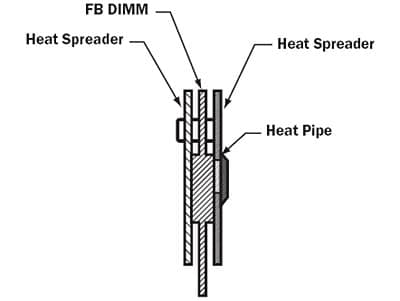 |
Figure 1. Cross-section of a FBDIMM memory module with heat spreader.
The heat spreader plates that exist today for the FBDIMM are either aluminum or copper. These spreader plates (front and back) form a sandwich around the memory module. Gap filler material or thermal grease is utilized for the interface between the AMB and DRAM packages. The main issue or drawback with this existing design is that a “hot spot” is usually formed in the vicinity of the spreader where it makes contact with the AMB. Because of the higher spreading resistance of the plate, the heat can not be transferred away from the AMB device efficiently enough. This results in higher AMB case temperatures.
By utilizing a heat pipe to spread the heat from the AMB device, the heat spreading efficiency is significantly improved. The heat pipe accomplishes this by absorbing the heat from the components in its evaporator section and transporting the vapor to the condenser sections at each end of the heat pipe thereby rejecting heat in the process. This results in a uniform spreading of heat along the length of the plate, thus eliminating the “hot spot” and resulting in lower AMB case temperatures.
Results and Discussion
Both CFD simulations as well as experimental tests were conducted to evaluate the effectiveness of the heat pipe heat spreader. A commercially available CFD code [1] was utilized to simulate the performance of this heat pipe spreader. The CFD study consisted of modeling both a conventional aluminum heat spreader for a baseline comparison as well as an integrated heat pipe spreader design. A single FBDIMM memory module was modeled in CFD with symmetry boundary conditions to reduce the computational time. The DIMM pitch considered during the analysis was 10mm, which is typically found in a server. The spreader designs were attached to the FBDIMM module and placed in a CFD wind tunnel with a fixed airflow boundary condition assigned at the inlet of the tunnel. The airflow boundary condition assigned to the CFD model ensured that the velocity between the DIMMS was approximately 2m/s. The total power of the FBDIMM memory module was 12W and the inlet air temperature was 25�C. Figures 2 and 3 show the temperature contours through each heat spreader design along with the respective AMB case temperatures. From this CFD analysis it is evident that by adding an integrated heat pipe into the spreader, the overall case temperature of the AMB device dropped by 12�C and the “hot spot” area around the AMB was virtually eliminated.
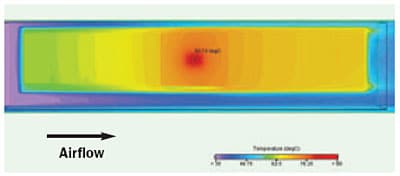 |
Figure 2. Aluminum spreader, Advanced Memory Buffer case temperature: 81�C.
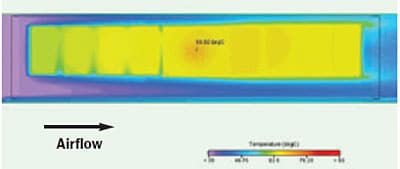 |
Figure 3. Aluminum spreader with heat pipe; Advanced Memory Buffer case temperature: 69�C.
The next step was to perform experimental tests to validate the results obtained from the CFD analysis. The working prototype consisted of an aluminum spreader plate with an integrated 8mm heat pipe that had been flattened to conform to the spreader plate as well as to the surface of the AMB chip. This prototype spreader was attached to a functional commercially available FBDIMM memory module. The assembly was attached to the AMB chip using a thermal grease interface and a gap filler material to fill the gap between the remaining DRAM’s and the heat spreader. The memory module was installed in a functional server that had a stress program installed to exercise the memory. A thermocouple attached to the surface of the AMB was used to monitor the AMB chip case temperature. The server was installed in an environmental chamber with the chamber temperature being held constant at 25�C. The thermal test was performed on a single memory module as shown in Figure 4. The other memory sockets were populated with FBDIMM’s with conventional aluminum heat spreader attached to the surface of the DRAM’s. Figure 5 shows the prototype of the aluminum spreader with integrated heat pipe. The test results shown in Table 1 are presented in terms of the rise in temperature, ΔTrise, defined as the difference in the case temperature of the AMB chip and the ambient temperature.
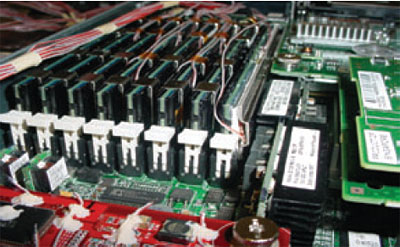 |
Figure 4. Heat pipe based heat spreader installed on functional FBDIMM.
Table 1. Comparison of Conventional Aluminum
Spreader and Aluminum Spreader with Heat Pipe.
|
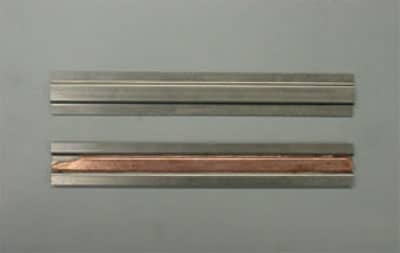 |
Figure 5. Prototype of a heat pipe based heat spreader.
Conclusions
The results show that the heat pipe based heat spreaders have improved thermal performance compared to conventional aluminum spreaders. Although the heat pipe based heat spreaders showed improved performance, they also add cost to the overall system and therefore it is imperative that the tradeoffs between the cost and performance should be evaluated before implementing a heat pipe heat spreader solution or for that matter any advanced thermal management technique.
References
- FLOTHERM, www.flomerics.com










